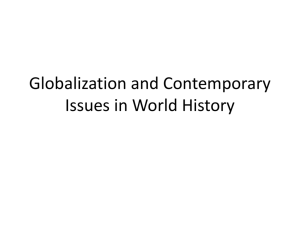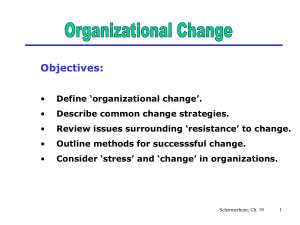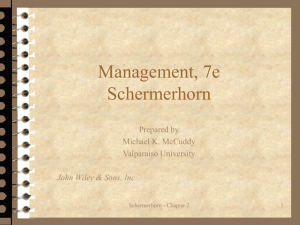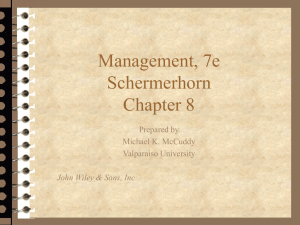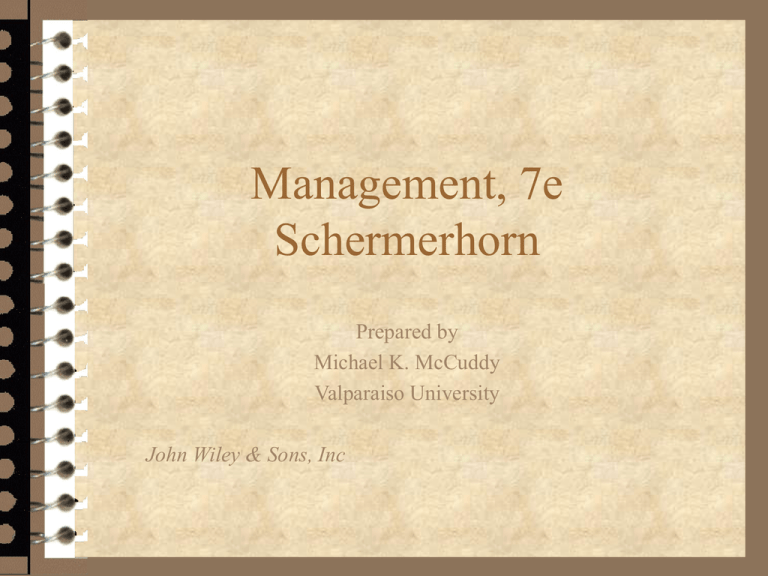
Management, 7e
Schermerhorn
Prepared by
Michael K. McCuddy
Valparaiso University
John Wiley & Sons, Inc
COPYRIGHT
Copyright 2002 © John Wiley & Sons, Inc. All rights reserved.
Reproduction or translation of this work beyond that named in
Section 117 of the United States Copyright Act without the express
written permission of the copyright owner is unlawful. Requests for
further information should be addressed to the Permissions
Department, John Wiley & Sons, Inc. The purchaser may make backup copies for his/her own use only and not for distribution or resale.
The Publisher assumes no responsibility for errors, omissions, or
damages, caused by the use of these programs or from the use of the
information contained herein.
Chapter 5
Global Dimensions of Management
Planning ahead—study questions
– What are the management challenges of globalization?
– What are the forms and opportunities of international
business?
– What are multinational corporations and what do they
do?
– How does culture create global diversity?
– How do management practices and learning transfer
across cultures?
Schermerhorn Chapter 5
3
What are the management challenges of
globalization?
Modern managers operate in a complex
global arena:
– Resource supplies, product markets, and
business competition are global in nature.
– There is a growing interdependence of supplies,
markets, and competition.
– Global managers must think and act globally.
Schermerhorn Chapter 5
4
What are the management challenges of
globalization?
Europe
– European Union (EU)
• Grouping of 15 Western
European countries that
agreed to support
mutual economic
growth
• Expected to expand to
at least 25 members
Schermerhorn Chapter 5
5
What are the management challenges of
globalization?
The Americas
– North American Free Trade
Agreement (NAFTA)
• Agreement for free flow of
goods and services
between the U.S., Canada,
and Mexico
– Free Trade of the Americas
(FTAA)—Alaska to
Chile—is a possibility
Schermerhorn Chapter 5
6
What are the management challenges of
globalization?
Asian and the Pacific Rim
– Rivals EU in size and is
growing
– Economic power of Japan
and China
– Asia-Pacific Economic
Cooperation (APEC) is a
growing regional economic
alliance
– Human rights and
intellectual property issues
Schermerhorn Chapter 5
7
What are the management challenges of
globalization?
Africa
– Beckons international
business
– Increased attention to
stable countries
– South African
Development
Community (SADC)
links 12 countries in
trade and economic
development
Schermerhorn Chapter 5
8
What are the forms and opportunities of
international business?
Reasons for engaging in international
business:
– Profits
– Customers
– Suppliers
– Capital
– Labor
Schermerhorn Chapter 5
9
What are the forms and opportunities of
international business?
Market entry strategies involve the sale of goods
or services to foreign markets but do not require
expensive investments.
Types of market entry strategies:
– Global sourcing
–
–
–
–
Exporting
Importing
Licensing agreement
Franchising
Schermerhorn Chapter 5
10
What are the forms and opportunities of
international business?
Direct investment strategies require major
capital commitments but create rights of
ownership and control over foreign
operations.
Types of direct investment strategies:
– Joint ventures
– Wholly owned subsidiaries
Schermerhorn Chapter 5
11
What are multinational corporations and
what do they do?
A multinational corporation (MNC) is a
business with extensive international
operations in more than one country.
Schermerhorn Chapter 5
12
What are multinational corporations and
what do they do?
Types of multinational corporations:
– Ethnocentric MNC
• Exerts strict control over foreign operations
– Polycentric MNC
• Gives foreign operations more freedom to operate as separate
entities
– Geocentric MNC
• Seeks total integration of global operations
Schermerhorn Chapter 5
13
What are multinational corporations and
what do they do?
Mutual benefits for host country and MNC:
– Shared growth opportunities
– Shared income opportunities
– Shared learning opportunities
– Shared development opportunities
Schermerhorn Chapter 5
14
What are multinational corporations and
what do they do?
Host country complaints about MNCs:
– Excessive profits
– Domination of local economy
– Interference with local government
– Hiring the best local talent
– Limited technology transfer
– Disrespect for local customs
Schermerhorn Chapter 5
15
What are multinational corporations and
what do they do?
MNC complaints about host countries:
– Profit limitations
– Overpriced resources
– Exploitative rules
– Foreign exchange restrictions
– Failure to uphold contracts
Schermerhorn Chapter 5
16
What are multinational corporations and
what do they do?
Ethical issues for MNCs:
– Corruption—illegal practices that further one’s business interests.
– Sweatshops—employing workers at low wages, for long hours and
in poor working conditions.
– Child labor—full-time employment of children for work otherwise
done by adults.
– Sustainable development—meeting current needs without
compromising future needs.
– ISO 14000—responsible environmental policies.
Schermerhorn Chapter 5
17
How does culture create global
diversity?
Culture
– The shared set of beliefs, values, and patterns of
behavior common to a group of people.
Culture shock
– Confusion and discomfort a person experiences in an
unfamiliar culture.
Ethnocentrism
– Tendency to consider one’s own culture as superior to
all others.
Schermerhorn Chapter 5
18
How does culture create global
diversity?
Popular dimensions of culture:
– Language
• Low-context cultures and high-context cultures
– Use of space
– Time orientation
• Monochronic cultures and polychronic cultures
– Religion
– Role of contracts
Schermerhorn Chapter 5
19
How does culture create global
diversity?
Values and national cultures (Hofstede):
– Power distance
– Uncertainty avoidance
– Individualism-collectivism
– Masculinity-femininity
– Time orientation
Schermerhorn Chapter 5
20
How does culture create global
diversity?
Understanding cultural differences (Trompenaars):
– Relationships with people:
•
•
•
•
•
Universalism versus particularism
Individualism versus collectivism
Neutral versus affective
Specific versus diffuse
Achievement versus prescription
– Attitudes toward time—sequential and synchronic
views.
– Attitudes toward environment—inner-directed and
outer-directed cultures.
Schermerhorn Chapter 5
21
How do management practices and
learning transfer across cultures?
Comparative management
– How management systematically differs among
countries and/or cultures.
Global managers
– Need to apply management functions across
international boundaries.
Schermerhorn Chapter 5
22
How do management practices and
learning transfer across cultures?
Planning and controlling:
– Complexity of international operating environment
– Political risk
Organizing and leading:
– Multinational organization structures
• Multinational geographic structure
• Multinational product structure
– Staffing international operations
• Competent locals
• Expatriates
Schermerhorn Chapter 5
23
How do management practices and
learning transfer across cultures?
Are management theories universal?
– U.S. management theories may be ethnocentric.
• Participation and individual performance are not emphasized
as much in other cultures.
– Not all Japanese management practices can be applied
successfully abroad.
• Lifetime employment, job rotation and broad career
experience, shared information, collective decision-making,
and quality emphasis.
• Keiretsu—long-term alliances for attaining common interests.
Schermerhorn Chapter 5
24
How do management practices and
learning transfer across cultures?
Global organizational learning:
– Companies can and should learn from each
other.
– Caution should be exercised in transferring
management practices.
– Cultural awareness facilitates more informed
transfers of management practices.
Schermerhorn Chapter 5
25


